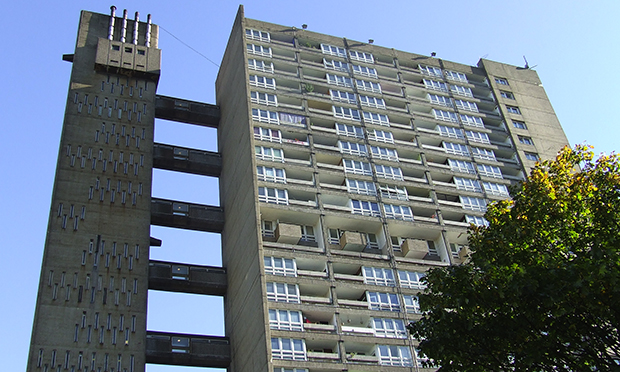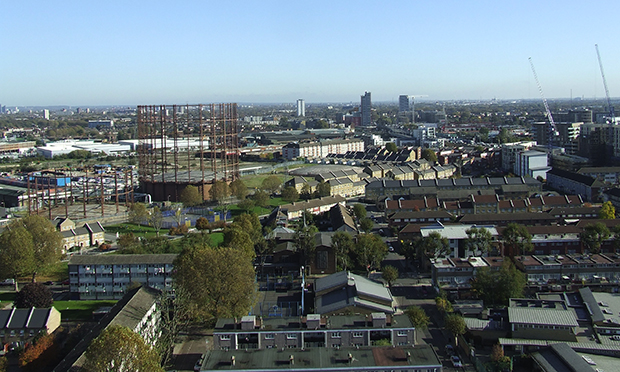How the Balfron Tower tenants were 'decanted' and lost their homes
Last month’s announcement that the Grade II-listed Balfron Tower in Poplar will no longer contain any social housing but will instead be sold as luxury flats put an end to speculation about its future that has been going on since 2010. But questions remain about its recent past, particularly around how more than 120 family-sized East London flats have passed from the social to the private sector without anyone being evicted.
For all that it is a gigantic and imposing concrete structure, Balfron is also delicate, with spindly, human-scale walkways connecting the service tower and main building. Six flats broad and one flat thick, it is endearingly awkward-looking; broad and slim, tall and squat, rough and rectilinear all at once. All bedrooms are on the eastern face, placed for the sunrise, with balconies to the west for its setting. Designed in the brutalist mood by British-Hungarian architect Ernő Goldfinger in the late 60s, it is touched by many such small elements of genius. The view is of London, from the Thames Estuary to Hampstead Heath.
For the better part of five years, Poplar HARCA, the housing association which owns the block, has maintained that the people who used to live there – social tenants who were “decanted” to allow refurbishment work to be carried out – might in theory be permitted to move back in. It stated several times that they “possibly but not probably” had a “right of return”.
This “right” wasn’t about law but about money: whether Poplar HARCA could afford to have any social housing in Balfron Tower. Until recently it was still unsure. In an interview conducted in January, Paul Augarde, head of Creativity and Innovation at Poplar HARCA, insisted he still did not know whether or not the budget for the Balfron project would have space for some social tenants to move back in. “It’s never great,” he said of what was then the possible total sale. “You don’t want to sell stuff.”
Poplar HARCA has a lot going for it. It owns and manages 6,000 social rent homes in Poplar and has built over 1,000 homes (social and private) in the last 15 years. It has refurbished all its social lets. It helps jobless residents into work, supports social enterprises in the area and even employs its own small police force. It persuaded Barclays to open the first non-charging cash point in the whole of Poplar and caused a bridge to be built over the four-lane East India Dock Road to connect estates together. It is making physical improvements to the area of a different magnitude to anything the council ever did.
Which goes some way to explaining why residents of the Brownfield Estate, of which Balfron and its neighbour Carradale House are part, voted for ownership and management of their homes to be transferred to Poplar HARCA from Tower Hamlets Council in 2007. But what has happened at Balfron is very different to what they actually voted for.
In 2006, residents were sent a booklet about transferring to Poplar HARCA, two pages of which were of special relevance to Balfron and Carradale. Poplar HARCA would be contractually obliged to refurbish substantially both blocks, and two options for their tenants were proposed: they could remain living in their flats while the refurbishment was carried out, or they could move, as priority tenants, into new homes Poplar HARCA would build elsewhere on the Brownfield Estate. If they took the second option, their current flat would be sold privately to help pay for the project.
Poplar HARCA anticipated around 130 tenants from across both blocks would choose to leave in this first instance. Balfron had suffered from an historic lack of maintenance and anti-social behaviour was a serious problem. Many tenants took Poplar HARCA up on its offer; but many others opted to stay.
In other words, the sale of some flats in Balfron was always on the cards, but so was the prospect of social tenants continuing to live there indefinitely. This initial proposal, on which tenants voted, made no mention of a “decant”, permanent or temporary, nor indeed of any need to leave Balfron at all.
How did we get from this state of affairs to last month’s announcement that the whole of Balfron, now empty of tenants, is to be sold privately?
Crash
Poplar HARCA blames two things: the 2008 financial crisis and the refusal of planning permission for a “linked” proposal for several separate developments it submitted to Tower Hamlets Council. Approval of this proposal would have given it a solid financial resource and lowered its reliance on the sale of unwanted Balfron and Carradale flats to fund the refurbishment and other projects. Forced to apply for new developments site by site, and sell homes at post-crash prices, these flats became one of its few solid sources of money.
Since these events occurred, tenants have been “decanted” and the uncertainty of their “possible but not probable” return promulgated. If – from 2008 onwards – Poplar HARCA strongly suspected it would need to sell Balfron, why didn’t it just make a clean breast of it?
Paul Augarde argues it was simply communicating the truth of the situation, which was that Poplar HARCA did not know what was going to happen. “We were very straight,” he says. “If we’d given an absolute answer” to residents’ questions on returning, he says, “it would have been no. It would have been easier to say no.”
Decant
Poplar HARCA did not attribute the need to remove tenants in 2010 to the need to sell Balfron, instead citing a report which detailed safety risks to their remaining while work was carried out. It decided on this basis to “decant” all tenants. This makes sense – quite how people could remain in flats while their bathrooms and kitchens were renovated has never entirely been made clear. But the “decant” also meant that the sale of homes would from then on always be connected to the prospect of tenants moving back in, not to their being moved out. The question of the sale of homes would be framed around a “right of return”, not a “right to stay”.
This was the manner in which the issue was presented to tenants, who were briefed by Poplar HARCA at the end of September 2010 on the need to leave their homes. The briefing could have been clearer: “Up until reading about the process of decanting I thought we were going to temporary housing and then return,” says Michael Newman, a tenant of Balfron for many years. Printed communications, however, boded ill: “The document that I looked at was on the process of decanting, and it made no statement that I could find on returning.”
The omission caused such alarm that by October it was the subject of an FAQ on a fact-sheet distributed by Poplar HARCA. “Can I move back in when the works are complete?” was “one of the questions we just don’t know the answer to yet”, the sheet stated, before raising the prospect of selling more Balfron flats than originally intended: “We have had to re-think how we pay for the works.”
In November 2010, Newman wrote an eloquent and moving letter to Andrea Baker, Director of Housing at Poplar HARCA, asking if there had been a misunderstanding: “[I] see my flat, my home, as a safe haven with memories of my brothers, and an inspirational, poetic view that has helped me through very difficult times,” he wrote. “I have lived for the past few weeks with the worry of losing my home.
“I am writing to ask you to reassure me about my home and our community.” Baker wrote back the very next day. But she was unable to offer anything further by way of reassurance than the “possibly but not probably have a right of return” formulation.
“Right of return”, not “right to stay”
From 2010, Poplar HARCA worked with residents on relocating. Building work was (and still is) yet to start. As years went by, the realistic option for waiting residents was to cease to pursue even a moral “right of return”.
“I have been treated very well by HARCA in the decant and do feel gratitude for how they supported the move,” says Michael Newman now. He has resettled in Carradale House. “I am now happy where I live. I can see my old flat from the balcony of my new one, and I am starting a new life.”
So is Balfron Tower. Now that all tenants have been re-housed, physically and psychologically, Poplar HARCA has finally applied for planning permission for the refurbishment and has formed a partnership with developer London Newcastle to sell the flats.
What comes of all this? It’s astonishing that a social landlord started with the plan of refurbishing a listed building for its social tenants and found that it was able to do so only if it sold the building into private hands – while still being contractually obliged to carry out the work. Other housing associations may well be put off by this from pursuing such ambitious projects, and it is a shame, to say the very least, that Poplar HARCA, for all its achievements, could not set them a better example.


